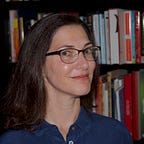Learning online
Yesterday I took a picture of a carpenter bee with some gooey stuff stuck to its face. The bee did not look well. It was moving slowly and trying very hard to dislodge the stuff which seemed to be keeping it from feeding properly. I looked online for what might have been wrong with the bee, and then I reached out to the one person I knew about who worked at the intersection of insects and fungi.
It is important to say I don’t really know Dr. Matt Kasson. I know of his work, but we’ve never met. I ran across one of his tweets a while back and started following him out of curiosity regarding his research of a fungus that kills cicadas. I found his description of the dead cicadas as “spore salt shakers” darkly humorous. And while I reserve Twitter as a space to learn about education, technology, and social justice, I figured throwing in a few insect-related accounts would only improve the experience.
So today, I tagged Dr. Kasson in a tweet and hoped he’d get back to me sometime in the next week. Within the hour I was having a conversation with three different highly qualified experts who responded and helped me out. We discussed the ailing carpenter bee, and as a thank you, I shared a picture of one of my latest fungal discoveries made during an exploration of the woods behind my house, a fungus called Trichoderma strictipile (image above). This led us in a new direction as they discussed what my picture showed.
Not sharing their expertise in fungi, I had nothing to add to the conversation. Instead, I pasted terms from their tweets into my browser to learn more. As usual, the top result was from Wikipedia. I read there, and not satisfied with my understanding, went to additional websites to read the same terms explained differently. I found definitions, explanations, and diagrams to better understand the different life stages and reproductive strategies of fungi: teleomorph, anamorph, holomorph.
As I did this, I was having an internal conversation I have often. I could have been a biologist. It was my first choice of career (the pipe dream of being an agent for the Israeli secret service notwithstanding), and it is what brought me to the United States as a college student. But then I got to my first organic chemistry class, with its 400 students in an auditorium and one unintelligible guy mumbling as he scribbled on a blackboard too far away for me to see and a dense, unhelpful textbook. Courses like these are kryptonite even to the most academically inclined students, let alone to an easily distractible person like me. I dropped the class and switched my major to Economics instead.
How would my life have been different if I’d been enrolled in that organic chemistry class today, with my iPhone and my connection to thousands of sources offering up better explanations for everything in my textbook? With the power of a search engine and Command-F at my disposal, and a world of helpful experts on Twitter?…
If this is true for me, it’s likely true for so many others. As Graham Brown-Martin discusses in his recent post about neurodiversity, we have too often treated ‘different’ as ‘deficient’ when we could have been learning together. I’ll be generous and assume this has always been due to resource limitations prior to today’s almost-limitless connectivity. But now we can do so much better: a better picture, an explanation using different words, a narrated video, a wider variety of examples than what the textbook publishers could fit on a page … all of these might reach learners better.
I do not want to imply that search engines, a smartphone, and social media mean anyone could be a biologist without attending college. I point out the possibility of a richer experience, one in which students can find what makes sense to them and talk it out with their classmates and their instructors — and a world beyond, where conversation leads to understanding. A conversation among a community of learners and practitioners enriches everyone’s understanding and gives learning a purpose beyond tests and grades. In this larger context, we know why it is important to know. It used to be difficult without connections. Now we have no excuses not to engage in this richer learning.
This is the experience I try to offer my own students when I tell them to use all resources at their disposal when working on projects: Google, the Scratch wiki, their classmates, anything. Just learn from them and then make your own product, understanding how and why you made it.
Yesterday, during a much shorter Twitter interaction with Héctor Abad F., I said it is important, especially as a teacher, to engage in learning of difficult tasks and concepts. Learning helps us find common ground with our students. Learning complex and difficult things helps us be empathic. And learning with and from experts online gives whatever we are learning a richer context and a purpose, helping us better understand how to provide these experiences for our students.
Originally published at https://medium.com on July 1, 2020.
